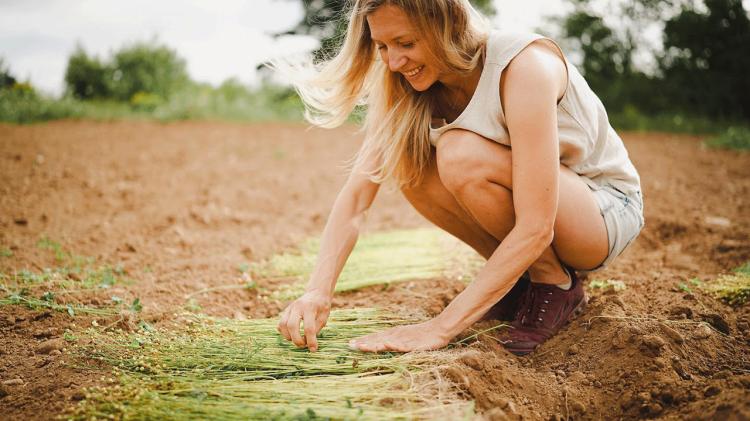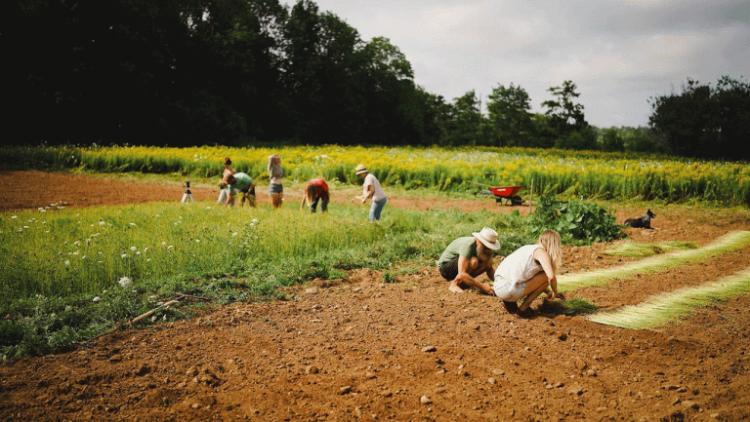Jennifer Green, associate professor, Division of Craft, has received $232,524.52 in funding from Research Nova Scotia (RNS) for her Flaxmobile Project: From Producer to Maker, Closing the Material Security Gap Across Mi'kma'ki.

NSCAD Associate Professor Jennifer Green harvesting flax. Photo by Lola Brown.
Building on a pilot study completed last year, this RNS Intentional Initiative Award enables Green to spend the next two years travelling the province in a converted cargo van to demonstrate flax growing from seeding to processing with farmers and craftspeople.
Green's primary aim for the Flaxmobile project is to create sustainable economies of scale to support a local supply of wool and linen in the province. By entwining growers and makers, she hopes to create solutions that can be carried out in harmony with the land and in collaboration with local communities.
Her research team, along with farmers and local fibre processor TapRoot Farms, will explore how this plant source for linen could support jobs, create new markets, and improve resilience in regional resource-based industries.
"This research project supports the economic potential of rural Nova Scotia," says Stefan Leslie, CEO of Research Nova Scotia. "The Flaxmobile project combines traditional craft practices and agricultural research developments to explore new opportunities for our province's sustainable bioeconomy."

Farmers and members of Flaxmobile project at work in fields harvesting flax. Photo by Lola Brown.
Citizen Scientists gathering data on flax growing across Mi'kma'ki
Green and her research team will work with 15 farmers and craftspeople around Nova Scotia from Caledonia on the south shore to the Margaree Valley of Cape Breton. She believes that closer relationships between farmers and craftspeople will become a source of valuable skill and knowledge for collective survival and sustainable futures.
"For most of the farmers, this is their first time learning how to grow fibre flax. We're working together every step of the way, from planting through to weeding, harvesting, retting, rippling, breaking, scutching and hackling. The farmers will have an experience of growing flax and collaborating directly with a textile maker, so that they're able to scale-up production and have a market for their fibres in years to come," says Green.
Working with a diverse group of farmers from around the province also enables Green to gather data on soil types, textures, humidity, rainfall, and temperature at each of these locations.
"It allows me to work alongside farmers as citizen scientists to gather data and re-establish knowledge of flax growing locally, which over the past two generations has been lost."
Collaborating with Cape Breton Centre for Craft and Design to lead systems change
In parallel with her fieldwork, Green will partner with researchers Rhonda Ferguson and Bailee Higgins (BFA 2022) at the Cape Breton Centre for Craft and Design (CBCCD) to explore how place-based methodologies might address issues of decolonization, equity, diversity, and inclusion in our communities and through our cultural outputs.
"This grant represents the first collaboration of its kind between NSCAD and the Cape Breton Centre for Craft and Design, and I am thrilled to be working with them," says Green.
Working with the CBCCD team, she will hire student assistants, graphic designers, photographers, and digital illustrators, to apply systems and transition design thinking to develop the craft sector as they explore the capacity for increased raw fibre production.
"Partnerships of this kind build bridges around the province and are essential if we want to address larger systems change," she says.

Dr. Jennifer Green in her Flaxmobile. Photo by Wiebke Schroeder.
Building a critical mass of farmers to create a consistent supply of high-quality materials
One of the issues that craftspeople face is the difficulty in sourcing quality textile materials locally. This makes it challenging to be both economically viable and sustainable as a craftsperson, Green explains.
As a professor, Green sees many students who want to transition to more sustainable textile and fashion practices, but at present, there is no established network for them to access local wool, linen, hemp, or natural dyes.
"Hopefully, in 10 years, a weaver would not need to concern themselves with this problem. We would have networks and an industry in place to access local materials," Green says.
"The work we are engaged in now, with other key partners in the province such as TapRoot Farms, is to build a critical mass of growers to create a consistent supply of high-quality materials."
Long-term plan to grow this sector in a holistic and sustainable way
The project has many deliverables, which Green believes are essential to growing the sector in a holistic and sustainable way.
They will publish a grower's guide for fibre flax to enable flax cultivation at the community level; create new materials, products, and markets by engaging craftspeople in the transformation of flax into linen textiles and garments; explore flax by-products in natural home building materials; and they will carry out supply chain mapping to visualize the textile ecologies that currently exist across the region.
"Looking to the future, I see this as a long-term project that I plan to stay a part of until there is enough momentum, and it becomes self-sustaining. After that, it can take off without extra help," says Green.
Follow Associate Professor Jennifer Green's project @flaxmobile on Instagram or on her website.
Learn more about NSCAD's BFA in Textiles/Fashion.













